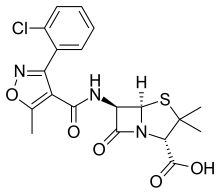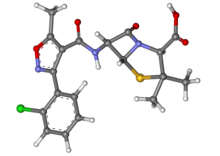Cloxacillin
 | |
 | |
| Clinical data | |
|---|---|
| Trade names | Cloxapen |
| AHFS/Drugs.com | Micromedex Detailed Consumer Information |
| Routes of administration | Oral, IM |
| ATC code | |
| Pharmacokinetic data | |
| Bioavailability | 37 to 90% |
| Protein binding | 95% |
| Elimination half-life | 30 minutes to 1 hour |
| Excretion | Renal and biliary |
| Identifiers | |
| |
| CAS Number | |
| PubChem CID | |
| DrugBank | |
| ChemSpider | |
| UNII | |
| KEGG | |
| ChEBI | |
| ChEMBL | |
| CompTox Dashboard (EPA) | |
| ECHA InfoCard | 100.000.468 |
| Chemical and physical data | |
| Formula | C19H18ClN3O5S |
| Molar mass | 435.88 g/mol g·mol−1 |
| 3D model (JSmol) | |
| |
| |
| (verify) | |
Cloxacillin is an antibiotic useful for the treatment of a number of bacterial infections. It is semisynthetic and in the same class as penicillin.
Cloxacillin is used against staphylococci that produce beta-lactamase, due to its large R chain, which does not allow the beta-lactamases to bind. This drug has a weaker antibacterial activity than benzylpenicillin, and is devoid of serious toxicity except for allergic reactions.
Cloxacillin was discovered and developed by Beecham.[1] It is sold under a number of trade names, including Cloxapen, Cloxacap, Tegopen and Orbenin. It is on the World Health Organization's List of Essential Medicines, the most important medication needed in a basic health system.[2]
See also
References
- ^ David Greenwood (2008). Antimicrobial drugs: chronicle of a twentieth century medical triumph. Oxford University Press US. pp. 124–. ISBN 978-0-19-953484-5. Retrieved 18 November 2010.
- ^ "WHO Model List of EssentialMedicines" (PDF). World Health Organization. October 2013. Retrieved 22 April 2014.
